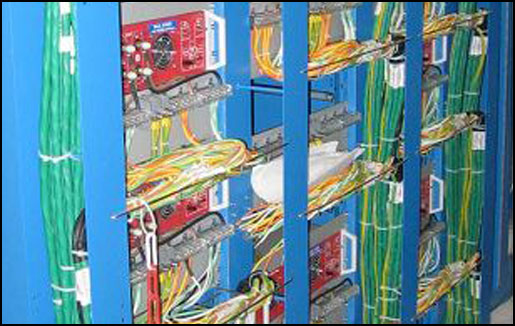
ATLAS e-News
23 February 2011
Muon cabling nears completion
7 April 2008

The assembled racks in US15
As the LHC switch-on date draws closer, and thoughts in the pit turn towards the closing of the ATLAS detector, one more box is almost ready to be ticked off: the installation of the muon cabling system.
“We’ve just got a few of the RPC detector flat cables to go in, but by the end of April, everything should be finished,” says Agostino Lanza, who has been responsible for overseeing the muon system cabling activity. The system mainly makes use of round cables, which are shielded, both to avoid disturbing the signals in other detectors, and to avoid noise picked up from the other detectors. The are more than 50 different types of cable, with diameters ranging from 3 millimetres (the Level 1 trigger sense cables), to 25 millimetres (the CSC low voltage cables).
“The total length of cables used is difficult to calculate,” admits Agostino. “The number of individual cables is around 16,000, so if you take an average length of 20 metres, you’re looking at more than 300 kilometres of cable.” His colleague, Matteo Beretta, describes these as “weighing tens of tons”.
“And this is just the cables on the outside of the detector – those connecting the components to the racks and to the control room and so on,” adds Agostino. “The number of cables in the muon system effectively doubles if you include those inside the detector in your calculations as well.”
The raw low voltage cable – tendered from Israel and sent to CERN about two years ago – required two trucks to transport it to the assembly company in Milan. There, these and the high voltage cable (tendered from Italy) were cut and fitted with connectors according to specifications drawn up by Agostino and cabling project leader, Sergei Malyukov.
“With no chambers installed, we had to evaluate the required lengths of the cables from the chambers to the rack, just on the basis of drawings. It was a huge job,” says Agostino. “Sergei was excellent; he had a clear picture of how he wanted the cables to be routed. He established the routes of the 60-centimetre ‘large cable trays’ first, so we had a path to follow.”
For the whole of 2006, and part of 2007, the company in Milan followed the list sent from CERN month-by-month, and shipped the completed orders back to CERN as they were ready. Once here, they were connected systematically, beginning in summer 2006. Sergei’s team was responsible for the bulk of the job, with a peak of sixteen of them dedicated solely to the muon cabling.
All the cables were realised in double length, always having a loop on the rack side, and connectors on the detector side, for testing purposes. Once installed, they had to be cut to correct length on rack side. “A few cables were 5-10 metres too long,” explains Agostino, “but some were too short, because of routing changes as we went along, so we had to extend them.”
From March 2007, the assembly company in Milan sent out small teams of people, for two or three weeks at a time, to cut the cables on the rack side, fit connectors on the rack side, and connect the shields to the ground. The connection work was largely completed by February this year, and all that was left to do was to connect up the HV cables of the MDT BEE chambers and some RPC HV connectors.
“This has been done in the last few weeks”, says Agostino, “by people who were hired to the muon group to help Sergei’s team during the installation, and to commission the installed cables. They come from Russia, Georgia, Greece, and Italy, and their contribution has been really invaluable.”
“The high voltage cables were all pre-tested before being connected to chambers,” he adds, “while the low voltage cables were directly tested once connected, using the power supplies as a testing tool.”
